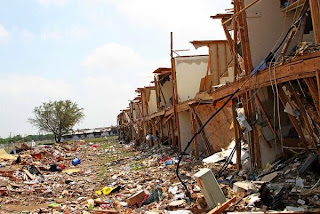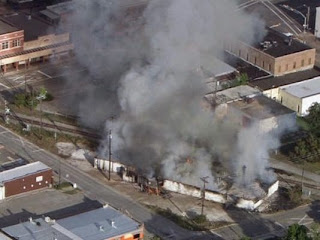BEST PRACTICES FOR THE STORAGE OF AMMONIUM NITRATE
References Related to Best Practices – Storage of Ammonium Nitrate
Please check with your local jurisdiction having authority to determine if there is a local fire code or other regulatory code that must be utilized related to storage of ammonium nitrate.
Occupational Safety and Health Administration (OSHA)
OSHA Standard 1910.109(i)(4) also defines additional requirements for storage of ammonium nitrate. The following are some, but not all the requirements:
1910.109(i)(5)(i)(a): “Ammonium nitrate shall be in a separate building or shall be separated by approved type firewalls of not less than 1-hour fire-resistance rating from storage of organic chemicals, acids, or other corrosive materials…”.
1910.109(i)(5)(i)(b): “In lieu of separation walls, ammonium nitrate may be separated from the materials referred to in paragraph (a) of this section by a space of at least 30 feet”.
1910.109(i)(6)(i): “Electrical installations shall conform to the requirements of subpart S of this part, for ordinary locations. They shall be designed to minimize damage from corrosion”.
1910.109(i)(7)(ii)(a): “Water supplies and fire hydrants shall be available in accordance with recognized good practices”.
The U.S. Senate Committee on Environment and Public Works held a hearing on June 27th in Washington, D.C., and various experts from the Chemical Safety Board, Department of Homeland Security, Texas A&M University, and others all agreed with Chairperson Boxer that fire must be prevented from reaching bulk storage of ammonium nitrate. Some recommendations included:
- Storage of ammonium nitrate in non-combustible storage facilities or at least have a one-hour fire barrier separating a storage bin of ammonium nitrate from other adjacent products
- Fire sprinklers suitable for a corrosive atmosphere
- Third party inspection of these facilities should be in place (i.e. insurance companies insuring these facilities, safety institutes, etc.)
NFPA 400 Hazardous Materials Code, 2013 Edition, Chapter 11 (Please refer to the entire standard. Below are some highlights from this NFPA standard and not inclusive of everything in this document).
Ammonium nitrate is rated as a Class 2 Oxidizer and a Class 3 Unstable Reactive requiring automatic fire sprinklers per 6.2.1.1
Portable extinguishers shall be provided throughout
the storage area and in the loading and unloading areas in
accordance with the fire prevention code adopted by the jurisdiction
and NFPA 10, Standard for Portable Fire Extinguishers.
Separation.
Ammonium nitrate shall be separated by fire barrier
walls of not less than 1-hour fire resistance or located in a
separate building from the storage of any of the following:
(1) Organic chemicals, acids, or other corrosive materials
(2) Compressed flammable gases
(3) Flammable and combustible materials, solids or liquids
(4) Other contaminating substances, including the following:
(a) Wood chips
(b) Organic materials
(c) Chlorides
(d) Phosphorus
(e) Finely divided metals
(f) Charcoals
(g) Diesel fuels and oils
Walls referred to in 11.2.12.1.1 shall extend from
the floor to the underside of the roof above.
In lieu of fire barrier walls, ammonium nitrate
shall be permitted to be separated from the materials referred
to in 11.2.12.1.1 by a space of at least 30 ft (9.1 m) or more, as
required by the AHJ, and sills or curbs shall be provided to
prevent mixing during fire conditions.
Incompatible Materials.
Flammable liquids, such as gasoline, kerosene,
solvents, and light fuel oils, shall not be stored on the premises,
unless the following criteria are met:
(1) The storage conforms to NFPA 30, Flammable and Combustible
Liquids Code.
(2) Walls and sills or curbs are provided in accordance with
11.2.12.1.1 through 11.2.12.1.3.
LP-Gas shall not be stored on the premises, unless
such storage conforms to NFPA58, Liquefied Petroleum Gas Code.
Indoor Storage.
Storage Conditions/Arrangement. Storage arrangement
shall be in accordance with 11.3.2.1 through 11.3.2.3.
Containers. Bags and containers used for ammonium
nitrate shall comply with the specifications and standards established
by the U.S. Department of Transportation (DOT).
Piles of Bags, Drums, or Other Containers.
Containers of solid ammonium nitrate shall not be
placed into storage when the temperature of the ammonium
nitrate exceeds 130°F (54.4°C).
Bags of ammonium nitrate shall not be stored
within 30 in. (762 mm) of the walls and partitions of the storage
Piles shall comply with the following dimensions:
(1) The height of piles shall not exceed 20 ft (6.1 m).
(2) The width of piles shall not exceed 20 ft (6.1 m).
(3) The length of piles shall not exceed 50 ft (15.2 m), unless
otherwise permitted by 11.3.2.2.3(4).
(4) Where the building is of noncombustible construction, or
is protected by automatic sprinklers, the length of piles
shall not be limited.
In no case shall the ammonium nitrate be stacked
closer than 3 ft (0.9 m) below the roof or its supporting overhead
structure.
Aisles shall be provided to separate piles by a clear
space of not less than 3 ft (0.9 m) in width, with at least one
service or main aisle in the storage area not less than 4 ft (1.2 m)
Piles of Bulk Solid Storage.
Warehouses shall have ventilation, or be capable of
ventilation in case of fire, that will, in the event of a fire, prevent
the explosive decomposition of ammonium nitrate.
Buildings shall be ventilated so as to prevent confinement
of decomposition gases.
Bulk storage structures shall not exceed a height of
40 ft (12.2 m).
Where bulk storage structures are constructed of
noncombustible material and facilities for fighting a roof fire
are provided, the height of the storage building shall only be
limited by the building construction type as specified in the
building code adopted by the jurisdiction.
Compartments.
Bins shall be clean and free of materials that can
contaminate ammonium nitrate.
Due to the corrosive and reactive properties of ammonium
nitrate, and to avoid contamination, galvanized iron,
copper, lead, and zinc shall not be used in bin construction, except
where such bins are protected against impregnation by ammonium
nitrate.
Aluminum bins, and wooden bins protected
against impregnation by ammonium nitrate, shall be permitted.
The warehouse shall be permitted to be subdivided
into any desired number of ammonium nitrate storage
compartments or bins.
The partitions dividing the ammonium nitrate storage
from the storage of other products that would contaminate
the ammonium nitrate shall be constructed to prevent
the ammonium nitrate from becoming contaminated.
The ammonium nitrate storage bins or piles shall
be clearly identified by signs reading AMMONIUM NITRATE
with letters at least 2 in. (50.8 mm) high.
Piles or bins shall be sized and arranged so that
all material in the pile is able to be moved out in order to
minimize possible caking of the stored ammonium nitrate.
The height or depth of piles shall be limited by
the pressure-setting tendency of the product; however, in no
case shall the ammonium nitrate be piled higher at any point
than 3 ft (0.9 m) below the roof or its supporting and overhead
structure.
Ammonium nitrate shall not be placed into storage
when the temperature of the product exceeds 130°F (54.4°C).
Dynamite, other explosives, and blasting agents
shall not be used to break up or loosen caked ammonium nitrate.
Floors.
All flooring in storage and handling areas shall be
without open drains, traps, tunnels, pits, or pockets into which
any molten ammonium nitrate is able to flow and be confined
in the event of fire.
Note: This is not an all inclusive list of best practices related to storage of ammonium nitrate, but is provided to provide highlights from three resources to facilitate further research by the property manager and/or owner.










No comments:
Post a Comment